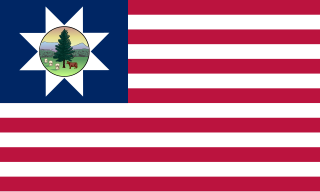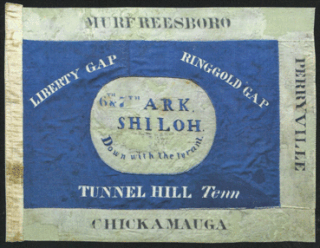
The 54th Massachusetts Infantry Regiment was an infantry regiment that saw extensive service in the Union Army during the American Civil War. The unit was the second African-American regiment, following the 1st Kansas Colored Volunteer Infantry Regiment, organized in the Northern states during the Civil War. Authorized by the Emancipation Proclamation, the regiment consisted of African-American enlisted men commanded by white officers.

The 12th Vermont Infantry Regiment was a nine months' infantry regiment in the Union Army during the American Civil War. It served in the eastern theater, predominantly in the Defenses of Washington, from October 1862 to July 1863. It was a member of the 2nd Vermont Brigade.
The 17th Wisconsin Infantry Regiment was an infantry regiment that served in the Union Army during the American Civil War. It was popularly known as the Irish Brigade, due to its composition of mostly Irish American immigrants.
The 102nd United States Colored Infantry was an African American infantry regiment of United States Colored Troops in the Union Army during the American Civil War. The unit was organized as the 1st Michigan Colored Volunteer Infantry Regiment before being redesignated as the 102nd Regiment USCT.
John Lucas Miller, Jr. was an attorney and state legislator in South Carolina who served as a colonel in the Confederate States Army. He was killed at the Battle of the Wilderness during the American Civil War.

The 75th Ohio Infantry Regiment, sometimes 75th Ohio Volunteer Infantry was an infantry regiment from southwestern Ohio in the Union Army during the American Civil War. It served in the Eastern Theater, most notably in the battles of Chancellorsville and Gettysburg and then in the siege operations against Charleston, South Carolina.
The 65th Regiment Illinois Volunteer Infantry, nicknamed the "Second Scotch Regiment" was an infantry regiment that served in the Union Army during the American Civil War. The regiment mustered into service in May 1862 and was captured at the Battle of Harper's Ferry. After being paroled and exchanged, the regiment was sent to Kentucky and assigned to the XXIII Corps. The regiment participated in the Knoxville campaign, the Atlanta campaign, the Franklin–Nashville campaign, and the Carolinas campaign. The soldiers were mustered out in July 1865.
The 3rd North Carolina (Volunteer) Mounted Infantry was an all-volunteer mounted infantry regiment that served in the Union Army during the American Civil War. The regiment was predominantly composed of Union Loyalists from North Carolina, but also included volunteers from Tennessee and several other states.

The 17th New York Veteran Infantry Regiment was an infantry regiment that served in the United States Army during the American Civil War. It was often referred to as the 17th New York Veteran Zouaves and has been erroneously reported as using mules as mounts during Sherman's March to the Sea up until the Grand Review of the Armies. The regiment wore the Hawkins Zouave pattern uniform, which was first used by the 9th New York Volunteer Infantry, Hawkins Zouaves, and later was adopted by several other regiments including the 164th New York, 35th New Jersey and others.
The 3rd Kentucky Infantry Regiment was a volunteer infantry regiment that served in the Confederate States Army during the American Civil War. It was part of the First Kentucky Brigade through August 1862.
Hispanics in the American Civil War fought on both the Union and Confederate sides of the conflict. Not all the Hispanics who fought in the American Civil War were "Hispanic-Americans", in other words citizens of the United States. Many of them were Spanish subjects or nationals from countries in the Caribbean, Central and South America. Some were born in a US Territory and therefore did not have the right to US Citizenship. It is estimated that approximately 20,000 Hispanics, mostly Mexican-Americans, Puerto Ricans and Cubans living in the United States joined the war: 2,500 for the Confederacy and 1,000 for the Union. This number increased to 10,000 by the end of the war.

The 18th North Carolina Infantry Regiment was an infantry regiment raised in North Carolina for service in the Confederate States Army during the American Civil War. It fought mostly with the Army of Northern Virginia.
The 13th Arkansas Infantry (1861–1865) was a Confederate Army infantry regiment during the American Civil War. Organized mainly from companies, including several prewar volunteer militia companies, raised in northeastern Arkansas, the regiment was among the first transferred to Confederate Service, and spent virtually the entire war serving in Confederate forces east of the Mississippi River. After the unit sustained heavy casualties during the Battle of Murfreesboro, the unit spent most of the rest of the war field consolidated with the 13th Arkansas Infantry Regiment, to form the 5th/13th Arkansas Infantry Regiment.

The 7th Arkansas Volunteer Infantry (1861−1865) was a Confederate Army infantry regiment during the American Civil War. Organized mainly from companies, including several prewar volunteer militia companies, raised in northeastern Arkansas, the regiment was among the first transferred to Confederate service, and spent virtually the entire war serving east of the Mississippi River. After the unit sustained heavy casualties in the Battle of Shiloh and the Kentucky Campaign, the unit spent most of the rest of the war field consolidated with the 6th Arkansas Infantry Regiment to form the 6th/7th Arkansas Infantry Regiment.

The role of Washington Territory in the American Civil War is atypical, as the territory was the most remote from the main battlefields of the conflict. The territory raised a small number of volunteers for the Union Army, who did not fight against the Confederate States Army but instead maintained defensive positions against possible foreign naval or land attacks. Although the Indian Wars in Washington were recent, there were no Indian hostilities within the area of modern Washington, unlike the rest of the western states and territories, during the Civil War. At the start of the American Civil War, modern-day Washington was part of the Washington Territory. On March 3, 1863, the Idaho Territory was formed from that territory, consisting of the entirety of modern-day Idaho, Montana, and all but southwest Wyoming, leaving the modern-day Washington as Washington Territory.
The 12th Arkansas Infantry (1861–1865) was a Confederate Army infantry regiment during the American Civil War. The regiment spent much of its service defending Confederate strong points along the Mississippi River. The unit participated in the defense of Island No. 10 in early 1862 and later became part of the garrison of Port Hudson in 1863. Following the capitulation of the garrison of Port Hudson, the survivors of the 12th were eventually paroled and exchanged back to Arkansas where the regiment was consolidated with the remnants of several other Arkansas regiments to become the 2nd Arkansas Consolidated Infantry Regiment.

The Second Battle of Pocotaligo, or Battle of Pocotaligo Bridge, or Battle of Yemassee, often referred to as simply the Battle of Pocotaligo, was a battle in the American Civil War on October 22, 1862 near Yemassee, South Carolina. The Union objective was to sever the Charleston and Savannah Railroad and thus isolate Charleston, South Carolina.
The Battle of Camp Davies was a skirmish during the American Civil War on November 22, 1863, near a Union Army camp about six miles south of Corinth, Mississippi. A 70-man detachment of the 1st Regiment Alabama Cavalry (Union), commanded by Major Francis L. Cramer, drove off a 150-man Confederate force of the 16th Battalion, Mississippi Cavalry State Troops, commanded by Major Thomas W. Ham, and killed at least 4 Confederate soldiers, while suffering two severely wounded troopers. This action is the only engagement recorded as occurring at or near Camp Davies in major sources on American Civil War battles. Other similar engagements in the vicinity of Corinth in 1863 may have occurred near Camp Davies.
The 12th Missouri Infantry Regiment was an infantry regiment that served in the Confederate States Army during the American Civil War. After mustering into Confederate service on October 22, 1862, as White's Missouri Infantry, the regiment, as Ponder's Missouri Infantry, fought in the Battle of Prairie Grove on December 7, where it charged the Union lines several times. On May 3, 1863, the regiment was named the 9th Missouri Infantry Regiment, and fought under that name until December 15, 1863, when it was renamed the 12th Missouri Infantry Regiment. On July 4, 1863, the regiment, as part of Brigadier General Mosby M. Parsons' brigade, broke through the Union lines at the Battle of Helena. However, Parsons' flanks were exposed, and the Confederates were driven from the field, suffering heavy losses. After Helena, only 168 men remained in the regiment. On November 22, 1863, the survivors of the regiment were combined into two companies, which were then attached to the 10th Missouri Infantry Regiment, although the 12th Missouri Infantry was still treated as a separate unit for reporting purposes. In April 1864, the 12th Missouri Infantry fought at the battles of Pleasant Hill and Jenkins' Ferry. On September 29, 1864, the survivors of the 12th Missouri Infantry were officially merged into the 10th Missouri Infantry, ending the 12th's separate service career.










